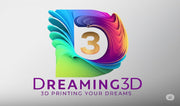Today, 3D printing feels like something straight out of science fiction — machines that can create intricate models, working parts, and even human organs layer by layer. But like most groundbreaking technologies, it didn’t appear overnight. The origins of 3D printing date back further than many people realize, and its history is a fascinating mix of engineering breakthroughs, creative problem-solving, and a vision for manufacturing’s future.
The Birth of 3D Printing: The 1980s
The roots of modern 3D printing go back to 1981, when Dr. Hideo Kodama of the Nagoya Municipal Industrial Research Institute in Japan filed the first known patent application for a rapid prototyping system. His method involved using a photosensitive resin that hardened under UV light, building objects layer by layer.
Unfortunately, Kodama’s project was never fully commercialized due to funding challenges, but it laid the foundation for what was to come.
The real turning point came in 1984, when Chuck Hull, an American engineer, invented stereolithography (SLA) — the first widely recognized 3D printing process. Hull’s innovation allowed designers to create physical prototypes directly from digital models, which was revolutionary for the time. He went on to co-found 3D Systems, one of the first companies to bring 3D printing to market.
Key Milestones in 3D Printing History
-
1981 – Hideo Kodama develops the earliest concept of layer-by-layer manufacturing using photopolymers.
-
1984 – Chuck Hull patents stereolithography (SLA).
-
1988 – The first commercially available 3D printer, the SLA-1, is released by 3D Systems.
-
1989 – Scott Crump invents Fused Deposition Modeling (FDM), a method that extrudes melted thermoplastic to build objects. He later co-founded Stratasys.
-
1990s – Selective Laser Sintering (SLS) emerges, enabling printing with powdered metals, plastics, and ceramics.
-
2000s – 3D printing moves beyond industrial applications into consumer use, education, and hobbyist markets.
-
2010s – The technology rapidly advances, with printers capable of creating everything from aerospace components to medical implants — and even food.
Why the 1980s Was the Perfect Time for 3D Printing’s Birth
The 1980s were a golden era for digital design and manufacturing innovation. Computer-Aided Design (CAD) software was becoming more accessible, allowing engineers to create complex digital models. At the same time, advances in laser technology, materials science, and computer processing power made it possible to turn these digital blueprints into physical objects.
The Impact of the First 3D Printers
When the first 3D printers arrived, they revolutionized rapid prototyping — allowing engineers to test and iterate designs much faster than traditional manufacturing. This capability reduced costs, shortened product development cycles, and opened the door for custom-made parts.
Over time, the technology evolved to handle new materials, larger build sizes, and higher precision, pushing 3D printing into fields like medicine, architecture, automotive, and even fashion.
From Invention to Global Industry
What began as a niche industrial process in the 1980s is now a multi-billion-dollar global industry. Affordable desktop printers, open-source communities, and advanced materials have democratized manufacturing, giving individuals and small businesses access to production tools once reserved for large corporations.
Looking back, the early inventors like Hideo Kodama, Chuck Hull, and Scott Crump couldn’t have fully predicted just how far their technology would go. But their groundbreaking work sparked a revolution that continues to reshape industries — and perhaps even the way we think about making things.
Final Thoughts
3D printing’s invention is more than just a date on a timeline; it’s the story of human ingenuity. From a laboratory idea in the early 1980s to a household technology today, it shows what happens when creativity meets engineering. And if history is any guide, the most exciting chapters of 3D printing are still to come.
